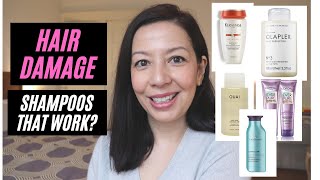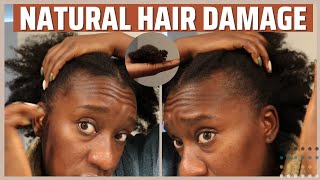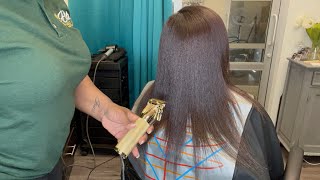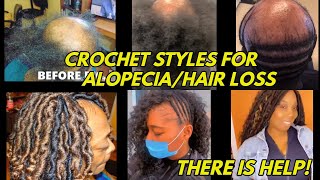Tips On How To Repair 5 Types Of Hair Damage
- Posted on 29 December, 2021
- Hot Topic
- By Martha O
Our natural hair experiences some form of hair damage from split ends, dry hair, to heat damaged hair. It could be that the daily manipulation of our hair can cause this wear and tear on the hair. Other times, the reason for this hair damage can be beyond our control, but instead of getting worked up for something we have no control over, how about taking some steps to heal them.
But before we jump into how to repair damaged natural hair, let's find out what hair damage is and its common causes.
What is Hair Damage?
Any type of hair damage usually happens when an aggressor like friction, heat, and harsh chemical treatments are introduced into the protective layers of your hair leaving it cracked [breakage]. Visual signs of hair damage may mean that your hair dry, frizzy, and difficult to manage. And this can leave your hair prone to breakage.
Hair damage can also be as a result of different factors. Here are some of them below.
3 Possible Causes Of Hair Damage
1. Stress
Stress disrupts the growth process of your hair by triggering your hormones to enter into a resting mode. This mode causes your hair to grow out prematurely as it no longer goes through the regular growth process, hence they fall off.
2. Dryness
Unusually dry hair is one of the precursors to damaged hair. When your hair does not receive regular and timely moisture, it becomes dry and brittle, and tends to break off when you comb through.
3. Incorrect brushing and combing
This happens when you comb your natural hair roughly and pull at knots in your hair aggressively. Rough combing can wreak havoc on your hair, damage your hair cuticles and make it prone to damage. Also, the harsher you comb your hair, the more prone it is to damage.
5 Types of Hair Damage and How To Repair Them
1. Split Ends
It is always easy to spot hair that has split ends. You would know your hair has split ends when it tangles a lot more, becomes dry, brittle, and breaks off often.
Solution: An effective way to repair split ends is to trim or cut your hair (ends) - depending on how much damage was done. Also, to avoid split ends, we recommend you trim your hair every two months and try to properly moisturize your hair from roots to ends on a daily or weekly basis.
How to get rid of split ends
Learn how to effectively get rid of split ends with this tutorial by Simply Subrena.
2. Colour Damage
It's totally okay if you want to add colour or dye to your natural hair. Who doesn't want to set heads turning with a blonde look today and a dark red hairstyle the next few days right? However, these products (dyes) contain chemicals which have the potential to strip your hair of its natural moisture. And when this happens, your hair becomes dry, fragile, and coarse to touch which can eventually lead to breakage.
Solution: If your hair is damaged by dyes, you can either cut it or wait for the beach to completely fade away. Also, you could consult with a hair professional to recommend a product specifically for your texture and porosity and that would repair the damage caused by the dye.
"Does this mean I should stop dying my hair?" Not at all. if colored hair is your preferred style, then you should ensure you moisture your hair on a daily basis or apply deep conditioning treatments more often. Also it is important that you engage the services of a professional colorist whenever you want to dye your hair.
How to repair colour damaged hair
See how you can repair hair damage caused by hair colouring or dyeing in this video by Savedbythestylist.
3. Mechanical Damage
If you notice that your strands are always tangled, has regular split ends, or that your edges are thinning, it is most likely that you have mechanical damage. This kind of damage is caused when you rough-handle your hair during manipulation, especially when you are detangling your braids or weaves.
Solution: Fortunately, there are ways to reverse this damage. You could use Beauty & Pin-Ups Fearless Hair Rescue Masque to restore your hair's vitality or try one of these detanglers to make combing easier for you.
How to treat mechanically damaged hair
In this video, Sofnfree will explain how you can repair a mechanically damaged hair.
4. Heat Damage
It is an unwritten rule for naturals that it is unhealthy to apply excessive heat to our hair strands. During hair styling, heat tools like hot combs, blow dryers, and hair straighteners tend to dry out the hair cuticle, make it weaker and eventually cause it to break off massively. The constant application of heat to your hair is never a good thing for your precious strands.
Solution: To reverse this damage, you can do the following; wear protective styles more often, deep condition your hair, trim your hair, or cut off everything. If you prefer to wear straight styles with your natural hair, you could try one of these no-heat methods for straightening hair or wear natural blow out hair extensions so you don't need to apply heat on your hair at all. But if you still insist on using heat on your hair, we recommend that you apply some heat protectant and allow your hair some breaks in between heat styling.
How to repair heat damaged hair
In this tutorial, Studio Techilo will show you how you can repair heat damaged hair.
5. Over-processed Hair
Over-processed hair happens because of the various products we use on our hair and all the treatments that we apply on our hair. They are usually as a result of incorrect or excessive use of bleach, perming, excessive use of hair styling tools, or hair relaxers.
Solution: How can you repair this damage? You can do either of the following:
- Get a haircut so that the split ends are removed
- Reduce the frequency of hairstyling. This will allow your hair to breathe.
- Invest in reliable, professional hair treatments.
- Apply home-made hair masks to keep your hair hydrated and nourished.
- Use a heat-protective spray before exposing your hair to heat styling methods like straightening, blow drying, or curling your natural hair.
How to repair over processed hair
Here's a video of Linwood showing how you can repair over-processed hair.
Tips for healthy hair
If you are experiencing any of the hair damages mentioned above, not to worry, you can still have a healthy head of hair. There are plenty of methods you can use to grow and maintain healthy natural hair, here are some of them.
- Trim regularly
- Moisturize your hair regularly
- Drink lots of water
- Stick to hair products recommended by a professional hairstylist.
- Protect your hair at night using bonnets
- Here are some more tips




